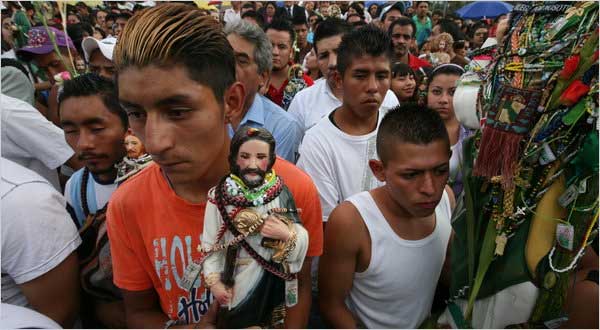
|  |  |  Editorials | Issues Editorials | Issues  
Speaking God’s Language, With a Gangster Dialect
 Marc Lacey - New York Times Marc Lacey - New York Times
go to original
July 24, 2010


| | Thousands of young people from some of the Mexican capital’s toughest vice-ridden neighborhoods have recently begun making monthly pilgrimages to San Hipólito Church carrying candles, rosaries and effigies of St. Jude, the patron saint of desperate causes, to hear the Rev. Frederick Loos. (Jennifer Szymaszek/New York Times) |  |
Mexico City — Frederick Loos was cussing like a sailor the other night, which was surprising given that he is a Roman Catholic priest and his foul-mouthed discourse was delivered from the pulpit to hundreds of faithful gathered before him.

He spoke of God, the need to serve him and how he can transform lives. But interspersed in his sermon was the most colorful of street Spanish, which brought smiles to the faces of many of the gang members, addicts and other young people pressed in tight to listen.

“When you go to China you have to speak Chinese,” the priest explained afterward, slipping out of his vestments. “If you’re speaking to kids you use their idioms. I don’t think God is offended if it brings them closer to him.”

Those enmeshed in Mexico’s thriving drug culture — users and traffickers alike — have an unusual relationship with the church. Sniffing glue and making the sign of the cross might not appear to go together any more than killing and the catechism. But for many believers in modern-day Mexico they do.

The huge flock that descends upon San Hipólito Church on the 28th of every month is made up of unconventional churchgoers, to say the least. Tattooed and pierced, the young faithful come from some of the capital’s most rugged neighborhoods, and many of them acknowledge that they run with gangs and use drugs. Drug use, in fact, is rife just outside the church entrance, where marijuana smoke fills the air and glue sniffing is the rage.

But a first-century saint that many Mexican youths have adopted as their own is having a mind-altering effect, as well. Thousands of young people from some of the Mexican capital’s toughest vice-ridden neighborhoods have recently begun making monthly pilgrimages to San Hipólito carrying candles, rosaries and effigies of St. Jude, the patron saint of desperate causes.

“I want to connect with God,” said a glassy-eyed teenager holding a St. Jude statue and sniffing glue, when asked about his religious fervor.

“Yeaaaaah,” said his friend, swaying precariously, also high on glue.

The youths arrive by subway, bus and bike from the capital’s roughest edges, eager for blessings. The church, somewhat uneasily, is trying to channel this unorthodox mass fervor. The Rev. René Pérez, the folksy parish priest charged with keeping the rowdy new flock under control, is hoping to reinvent St. Jude as an unofficial local patron saint of addicts. “We don’t have a magic wand, but we do want to take advantage of this faith they have,” Father Pérez said.

As a result, he accepts drugs in the collection baskets if followers care to give up their vices on the spot. He also brought in Father Loos, 74, an American who has lived in Mexico for more than four decades and whose barrio slang helps him to relate to the newcomers.

“It’s a tremendous phenomenon, and nobody understands it,” said Father Loos, noting that the drug use stops at the church entrance. “They are clearly in need of help for their many problems. They carry these St. Jude statues, some of them bigger than they are. St. Jude is something that has become close to them.”

Hoping to prevent their fascination with St. Jude from morphing into an interest in Jesús Malverde, a 20th-century outlaw who has been adopted as a saint for those in the drug business, the church is eager to channel the young people’s faith into the mainstream church. Some traditional churchgoers, though, do not particularly care for the foul language, and a group of them caught up with Father Pérez the other night to protest Father Loos’s words.

The young Mexico City churchgoers are by no means the only ones meshing religion with vice. Powerful drug dealers in other parts of the country have been known to give sizable donations for church repairs and other projects. Calling traffickers “very generous,” Bishop Carlos Aguiar Retes, president of the Mexican Bishops Conference, drew controversy last year when he was quoted by the newspaper Reforma crediting them with building churches, chapels and other infrastructure.

In Michoacán, a state in central Mexico known for its marijuana growing and methamphetamine production, a twisted version of the Bible has been adopted by a drug gang known as La Familia.

“I ask God for strength and to give me challenges to make me strong,” the homegrown scripture goes. “I ask him for wisdom and to give me problems to solve. I ask him for prosperity and to give me brain and muscles to work.”

It is signed by Nazario Moreno, La Familia’s spiritual leader, who goes by the nickname El Más Loco, or The Craziest One.

While this parish in Mexico City is trying to persuade troubled youths to give up their vices, El Más Loco has created a cult in the countryside that uses religion to justify his group’s murderous ways, whether that means killing police officers trying to interrupt its drug business or eliminating rivals by chopping off heads. That good and evil could be so dangerously out of whack has the pastors here shaking theirs.

“Most of these people who are killing each other are baptized Catholics,” said Father Loos. “How can they do what they’re doing? The violence is so sadistic. How can they go home at night and hold their children? I can’t figure it out.”

Greg Brosnan contributed reporting. |

 |
|  |



